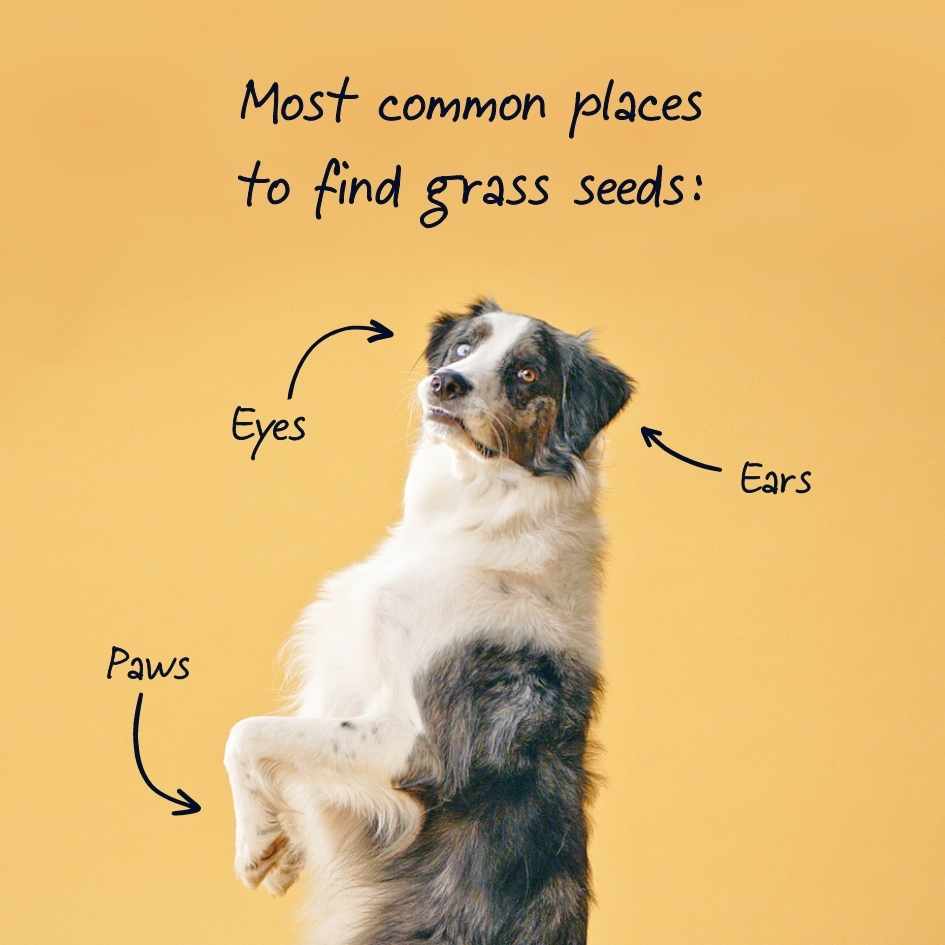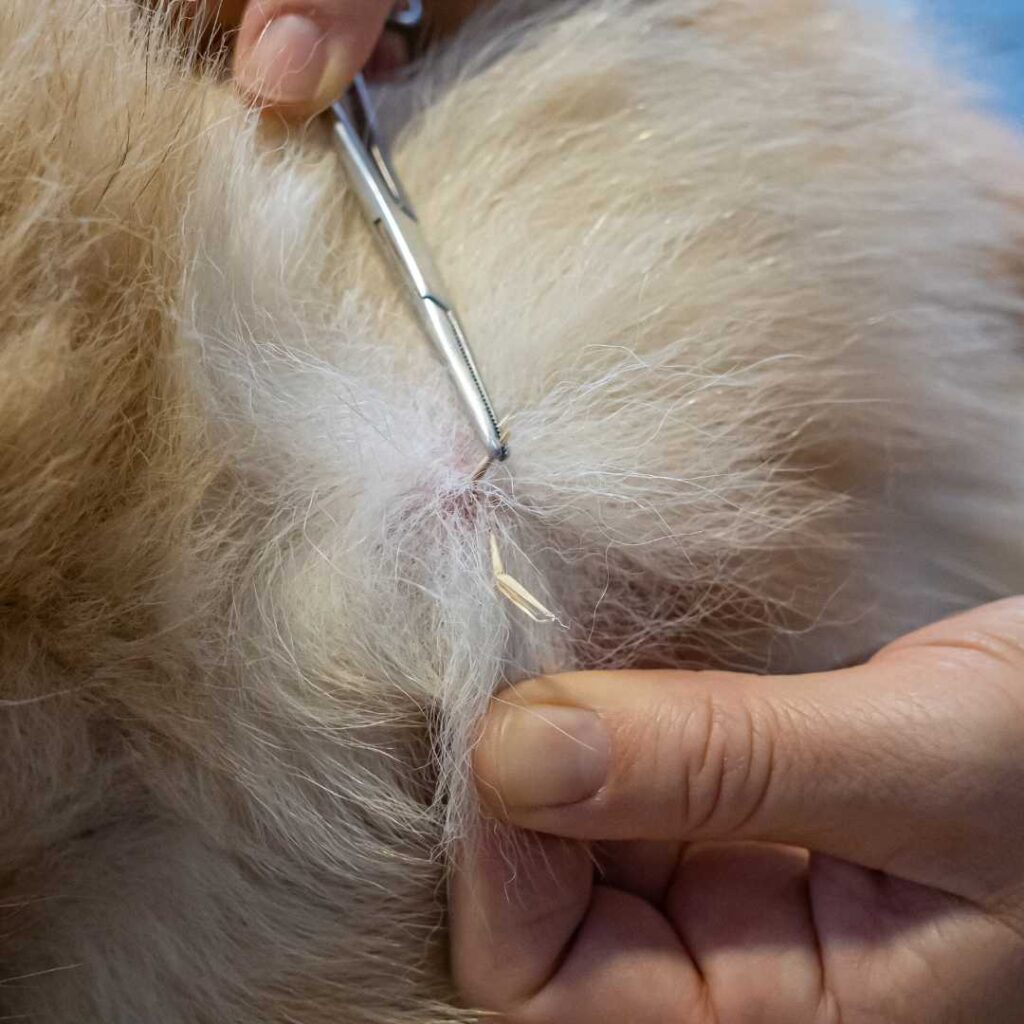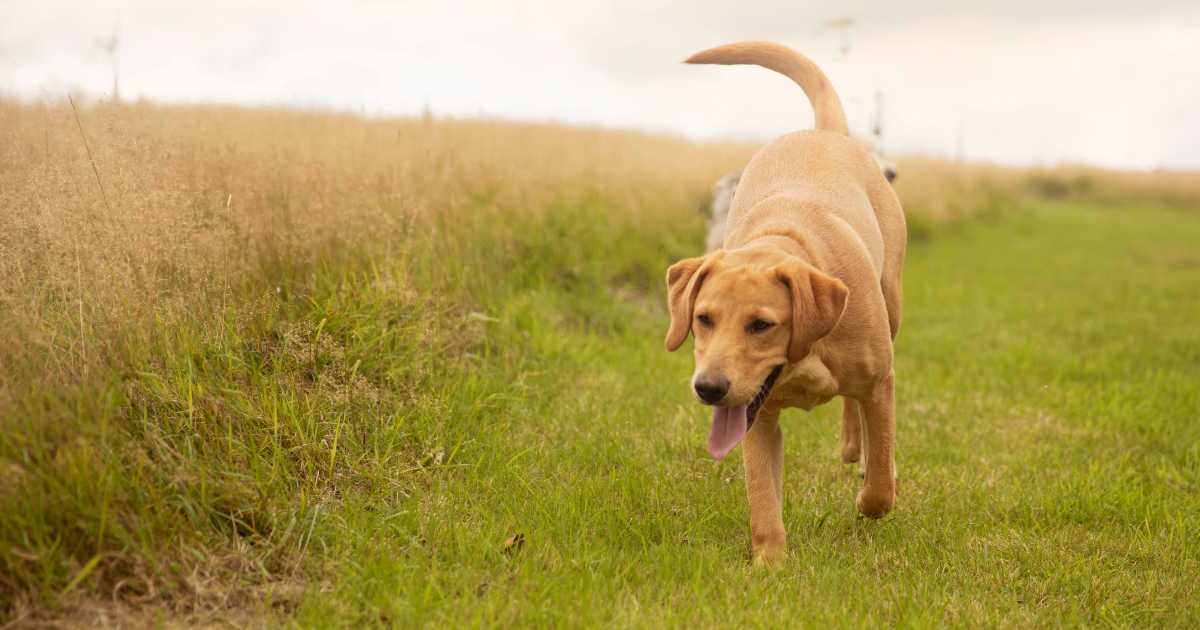Taking a leisurely stroll with your dog across a grassy field is one of the best things about having a walking buddy. But during the summer, it’s important to be aware of pesky grass seeds, so you can help your dog frolick safely through the warmer months.
In this post, we’ll give you the lowdown on grass seeds, explain why they can be harmful for your dog and help you avoid them.
What are grass seeds?
Grass seeds are small, pointy seeds found at the top of long grass stems. You’ll usually spot them in meadows and woodlands, particularly in late spring and throughout the summer.
Although grass seeds are pretty small, they have sharp ends. Unfortunately, this means they can get stuck in your dog’s fur, paws, ears, eyes and nose. If they get trapped in the fur, they can also burrow down and pierce your dog’s skin.
Why grass seeds can be harmful for your dog
While they look small and harmless, grass seeds can cause a lot of issues and it’s important to remove them quickly. Their pointy shape makes it easy for them to pierce through skin and enter your dog’s body. This can then cause problems like abscesses or infections. The tricky thing is that once grass seeds get under the skin, they’re really difficult to find.
If you find a grass seed that’s stuck in your dog’s skin, or a wound or swelling that looks like it could contain a grass seed, definitely book an appointment with your vet.
Checking your dog for grass seeds
If your dog’s been running through long grass, it’s important to check their fur and skin for grass seeds. This means getting hands on with your dog – gently pulling their fur back, looking inside their ears, and feeling for any lumps or bumps on their body.
Where to look
While it’s important to check your dog all over, the most common places grass seeds are found are:
- Ears
- Eyes
- Paws – including between the toes and behind their pads

And don’t forget to give them a treat or use a LickiMat recipe to reward them sitting through the checks!
Signs your dog’s been affected by a grass seed
If your dog has a grass seed stuck in their paw, ear, nose, eyes or skin, you may notice them:
- Licking their paw constantly and vigorously
- Having a red or painful swelling between their toes
- Limping
- Shaking their head
- Pawing at their ear or rubbing it against surfaces
- Sneezing suddenly or violently
- Having redness, swelling or discharge in their eye
- Chewing or licking at a sore spot on their skin
If you notice a wound that’s not healing, this could be due to a grass seed that’s travelling around your dog’s body. Other telltale signs include low energy or an occasional high temperature.
It’s important to contact your vet as soon as possible if you see any of these signs in your dog.
Protecting your dog against grass seeds
It’s difficult to completely avoid long grass during the summer, but these tips can help you avoid grass seeds as much as possible.
- Avoid long grass when you can, especially if you can spot grass seeds.
- Always check your dog for grass seeds after walks in long grass.
- Keep them well groomed so it’s easy to spot grass seeds lodged in their fur.
- Contact your vet immediately if you think your dog could be suffering from a grass seed injury.

Dealing with grass seed issues
See a grass seed in your dog’s fur which hasn’t pierced the skin yet? You can go ahead and carefully remove it at home to prevent further injury. However, if you spot a grass seed that’s started to burrow into your their skin, or you think your dog might have a seed in their eye or ear, contact your vet immediately.
For seeds stuck in the skin, it might be possible for your vet to pull them out with specialist tweezers. Once a grass seed has worked its way into your dog’s body, it’s much harder to find, because it show on x-rays.
Because they can cause so many problems, your vet might suggest investigating further if they suspect a grass seed-related issue. This can happen even if they can’t see or feel a grass seed when they examine your dog.
Eyes
If your dog has a grass seed behind their eyelid, they’re likely to need a local anaesthetic or sedation to remove it. Your vet will also check the surface of their eye to make sure the seed hasn’t caused any damager.
Ears
If your dog has a grass seed in their ear, your vet might be able to see and remove it easily. However, if the ear is very painful or the seed is further down, your dog may need sedation for it to be removed. If it’s caused an ear infection, your dog will also need treatment for that.
In between toes
Finding a grass seed in between toes can be challenging. This is because they often make their way under the skin and cause swelling between the toes (an interdigital cyst). If it’s just beneath the skin, your vet may be able to remove it while your dog is awake, but it’s likely they’ll need an operation to find it.
Anywhere else?
If your vet thinks your dog has a grass seed migrating somewhere in their body, they may recommend specific tests, like a CT scan, and possibly surgery.
While the treatments above sound a bit scary, remember grass seed injuries this severe are pretty rare. Prevention and regularly checking your dog – following the tips in this blog – are the best way to keep them safe. So there’s still plenty of fun summer walking to be had!
Looking for more tips and advice? Check out our blog.


Thankyou for this amazing Information through your Blog. We will now take care of our dog after he comes back from walk.
Going to make my husband read this article as throws the ball into long grass on occasion and the dog sometimes lies down in the long grass. Tobie (the dog) is going to the vet tomorrow as he has a red rash on his tummy now.
My young female Shipoo, Carys, had an abscess next to her urethra, the vet lanced it and it was healing then a few days later another abscess developed above her urethra, the vet took her in this time to explore under sedation and found the offending GRASSSEED! Now Carys has an open healing wound and plastic protective collar…